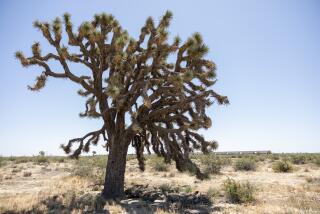Scientist has a soft spot for the hard-shelled creatures of the desert
- Share via
If nature has its way, the tiny desert tortoise that was creeping across Glenn Stewart’s palm will grow to roughly the size of a soccer ball, live 100 years and make a meaningful contribution to the planet Earth.
But things aren’t looking too good for the tortoises that roam the Southern California desert.
Chances are that, if placed in its natural habitat, the small creature living in Stewart’s laboratory would be eaten by ravens. Or it could die of starvation because its habitat has been taken over for man’s uses. If it survived and lived to maturity, it could still fall victim to gunmen known as “plinkers” who kill the slow-moving tortoises for target practice.
For now, it has a safe home in the zoology department at Cal Poly Pomona, where Stewart is a professor of zoology and an authority on environmental conservation.
“As a little kid living in Perris, I kept up to 20 at a time as pets, and nobody thought these would become an endangered species,” said Stewart, 52.
Stewart describes himself as an outdoorsman by nature who was born with a love for animals. His affection for tortoises began when an uncle, who had a mine in the Mojave Desert, brought him a pair of tortoises that mated and multiplied.
In a similar way, that’s how the 5-month-old tortoise came to be in Stewart’s hand one day last week. One of his students, who also is fascinated by them, had a pair of adult tortoises that mated, and she gave the newborn to Stewart.
Where 50 years ago the tiny reptile would have been among 1,000 tortoises in every square mile between Palmdale and Barstow, that area’s tortoise population is now about 20 per mile.
Stewart said he first discovered that the tortoise population was diminishing 20 years ago, when he returned to Southern California after five years of graduate study at Oregon State University. As a result, he and other professionals in wildlife conservation founded the Desert Tortoise Council, whose goal is to keep the tortoises from becoming an endangered species. The reptiles are currently listed by state and federal agencies as “sensitive,” indicating that their numbers are declining.
The council’s 150 members come from the same territory the tortoises do--Southern California, Nevada, Arizona and part of Utah. The group works with agencies to try to protect tortoises and their habitat.
One of the reptiles’ major contributions to the life cycle, Stewart said, is the long, deep burrows they dig that provide shelter for burrowing owls, snakes, rodents, lizards and insects.
Stewart said he is equally fascinated with snakes, which he also collected as a child and which he defends as “badly misunderstood. I just don’t understand why some people don’t like them.” He is an authority on several snake species, including two that are on endangered lists: the San Francisco garter snake and the southern rubber boa, which lives only in the San Bernardino Mountains.
Stewart also works with a colony of American black bears that live in the San Gabriel Mountains and is one of a few scientists allowed to track the bears’ movements with radio devices.
Stewart believes one of his major contributions to nature is a class he teaches called Environmental Conservation, in which students discover the ways they might be unwittingly contributing to the destruction of wildlife.
He said that when students are asked to write evaluations of the class, they consistently say: “Everyone ought to take this course.”
Phil Pister, biologist with the California Department of Fish and Game, said: “Glenn is a real bright star in the conservation work we do. He’s a widely renowned herpetologist, and some of his most valuable work is teaching conservation to students and getting actively involved in society outside of academic circles.”
Stewart said his students learn how to use water--such as “don’t use the hose to wash the driveway, so we won’t have to go out and find more water resources.” Instead, he suggests sweeping driveways.
He also urges minimum use of lights, heat and air conditioners, recycling materials and finding ways to cut back on energy use.
Without these measures, he said, more dams will be built to provide fresh water and power for Southern Californians. The result, he said, will be destruction of riparian habitats for hundreds of animal species and “otherwise screwing up the water system” by channeling Northern California water from the Delta region to Southern California.
“No matter where you look for energy, you’re still talking about destroying the environment,” Stewart said. “Even solar energy projects cover many miles of habitat.”
Stewart gently put the baby tortoise back in a cage where it will live safely, perhaps for six to eight years, until its shell is hard enough to fend off predators.
And then?
“I just don’t know.” Stewart said. “It belongs in the desert. You want to make that possible.”
More to Read
Sign up for Essential California
The most important California stories and recommendations in your inbox every morning.
You may occasionally receive promotional content from the Los Angeles Times.













